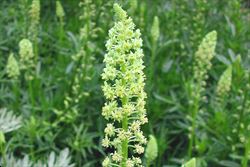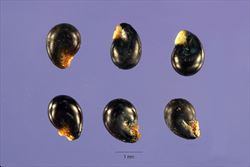Click on images to enlarge

infestation (Photo: Greg Jordan)

habit (Photo: Matt Taylor)

stem and deeply-divided leaves (Photo: Greg Jordan)

elongated flower cluster (Photo: Matt Taylor)

close-up of flower showing lobed petals and stamens (Photo: Greg Jordan)

close-up of underside of flower showing narrow sepals (Photo: Greg Jordan)

close-up of seeds (Photo: Jose Hernandez at USDA PLANTS Database)
Scientific Name
Reseda lutea L.
Family
Resedaceae
Common Names
cut-leaf mignonette, cutleaf mignonette, cut-leaved mignonette, wild mignonette, yellow mignonette
Origin
Native to northern Africa (i.e. Algeria, Egypt, Libya, Morocco and Tunisia), the Madeira Islands, the Canary Islands, Europe (i.e. France, Portugal, Spain, the Netherlands, Poland, Albania, Bulgaria, Greece, Italy, Malta, Romania, Yugoslavia, Belarus and Ukraine) and western Asia.
Naturalised Distribution
Widely naturalised in southern and eastern Australia (i.e. in south-eastern Queensland, in the sub-coastal and inland districts of eastern New South Wales, in southern and north-western Victoria, in Tasmania, in many parts of South Australia and in south-western Western Australia).
Notes
Cut-leaf mignonette (Reseda lutea) is regarded as an environmental weed in Western Australia and is listed as a priority environmental weed in at least one Natural Resource Management region.
While this species is mainly a weed of agricultural areas (i.e. crops, pastures, roadsides and waste places) it may also invade natural vegetation in some situations. In Western Australia it is mainly found on calcareous soils in the south-western parts of the state.

